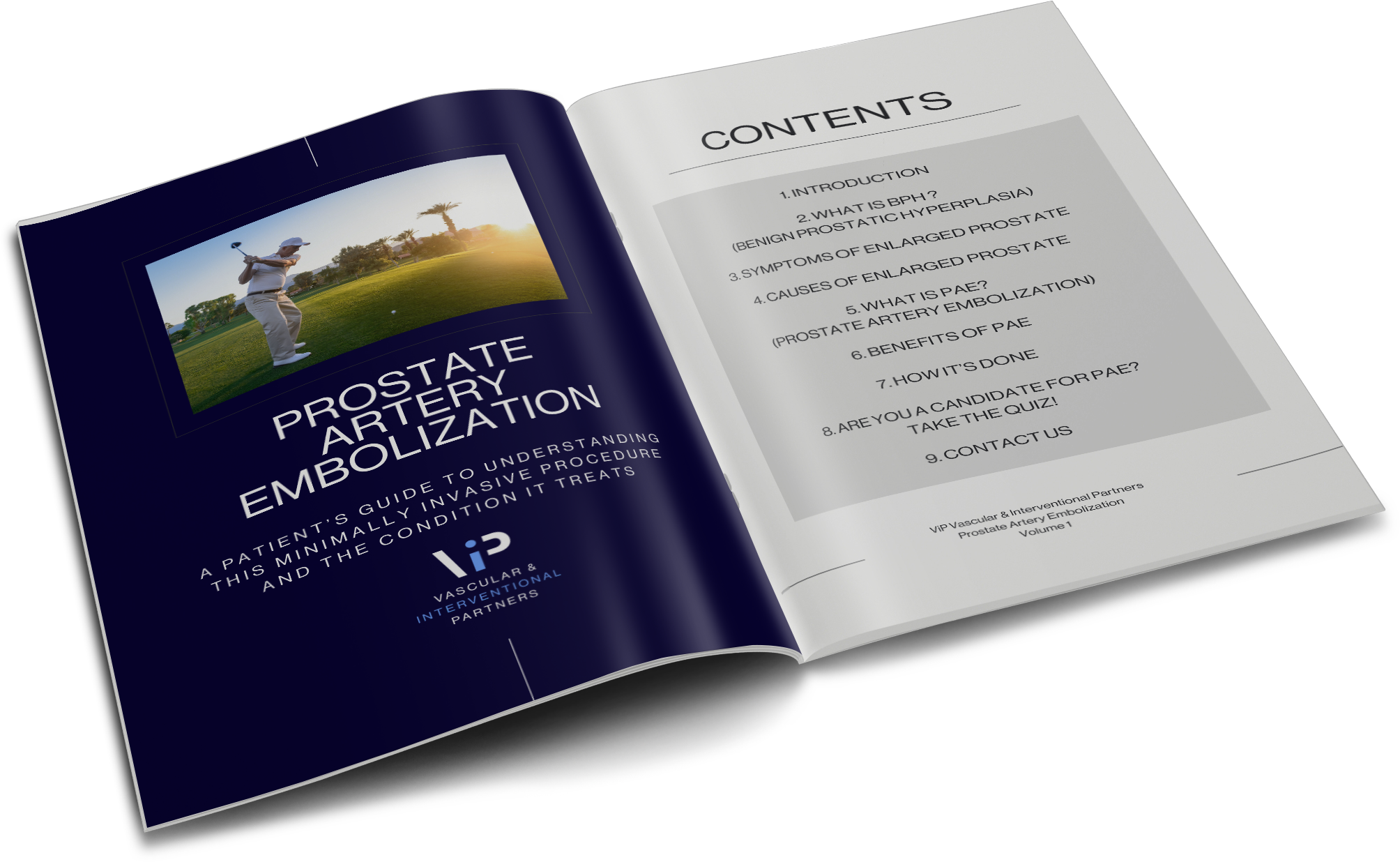
Prostate Artery Embolization
Prostate Artery Embolization Procedure
Prostate artery embolization (PAE) is a minimally invasive procedure for treating benign prostatic hyperplasia (BPH).
The team of specially trained interventional radiologists at Vascular and Interventional Partners regularly performs PAE. As an alternative to more invasive surgical procedures, prostate artery embolization is normally done on an outpatient basis. This minimally invasive procedure comes with fewer risks and allows for a quicker recovery. It can help relieve pain and discomfort by blocking blood flow to the arteries supplying the enlarged prostate.

What Is Benign Prostatic Hyperplasia?
The prostate is a small walnut-shaped gland in men. It is located in the pelvis around the urethra, a tube that carries urine into the bladder.
Benign prostatic hyperplasia (BPH) is a noncancerous enlargement of the prostate. The increased size of the prostate can narrow the urethra, causing difficulties with urination.
Benign prostatic hyperplasia (BPH) -- sometimes simply called prostate gland enlargement -- is a noncancerous enlargement of the prostate, not prostate cancer. The increased size of the prostate can put pressure on the urethra, causing difficulties with urination and ejaculation.

Symptoms of BPH can include:
- Frequent urination during day and night
- Slow urination or dribbling
- Urinary hesitancy (difficulty starting urination)
- Urinary urgency (sudden need to urinate)
- Change in the color/smell of urine
BPH is the most common prostate condition in men with age. Approximately 50% of men will have it by age 60, and over 90% by age 80.
Treatment can range from medications to surgeries such as TURP (transurethral resection of the prostate) and Urolift.
What Is Prostate Artery Embolization?
Prostate artery embolization (PAE) is a minimally invasive treatment option for BPH.
During a PAE procedure, your doctor inserts a tiny catheter into your artery in the groin or in the wrist. Under x-ray guidance, the catheter is directed into the prostate arteries in the pelvis. Microscopic particles are then injected to block off (embolize) the blood supply to the prostate. The enlarged prostate will shrink in size, approximately 20-40% over 3-6 months, relieving the BPH symptoms.
PAE is usually performed on an outpatient basis. There is no need for general anesthesia during the procedure. Instead, we will use a local anesthetic and mild to moderate sedatives to help you feel relaxed and not experience any pain.



Preparing for Prostatic Artery Embolization
During your consultation at our Scottsdale clinic, we will provide you with detailed instructions on preparing for this procedure.
Before your procedure, we will take a careful look at your medical history and perform blood work and other medical testing to see if this procedure is right for you. We may ask you to stop taking certain medications such as blood thinners a few days before your procedure. You will also need to avoid all food and drink on the night before your procedure and arrange for someone to drive you home upon your discharge.
Like most medical procedures, PAE comes with risks as well as benefits.
- As a minimally invasive, same day outpatient procedure
- Short recovery time, usually within four days to ten days
- Has the same success rate as surgical treatments but with fewer risks
- Low risk of sexual side effects, urinary incontinence and retrograde ejaculation
- No need for a catheter following surgery
- Infection at the puncture site or the prostate
- Irritation to the bladder and surrounding area
- “Post-PAE syndrome,” which can include digestive upset, fever, pelvic pain, or painful/ frequent urination
- Blood in the urine or stool in the days after the procedure
- Bladder spasms
Learn more about Prostate Artery Embolization
At Vascular & Interventional Partners, we know that BPH can cause uncomfortable lower urinary tract symptoms and reduce a man’s quality of life. We also know that patients prefer the most effective and minimally invasive treatment options available, so we help men find relief from BPH pain and complications with prostate artery embolization. To learn more about this procedure and find out if it is right for you, {email} or call us today at {phone}.


Frequently Asked Questions
Is prostate artery embolization covered by insurance?
Most insurance companies cover embolization procedures; however, you will need to contact your insurance provider to determine what your specific plan covers. Our in-house precertification specialist can guide you through the preauthorization process.
Is prostate artery embolization FDA-approved?
Yes! The FDA approved PAE in 2018 for the treatment of enlarged prostates.
How effective is prostate artery embolization?
According to current research, around 75 to 85 percent of men treated with PAE see improvement in their symptoms. The procedure maintains effectiveness for at least three years following treatment.
How long does prostate artery embolization surgery take?
PAE takes around one to four hours to complete. You may need to prepare for treatment a couple of days to weeks in advance. Recovery from surgery should take you no longer than 10 days.
Does prostate artery embolization cause erectile dysfunction?
Compared to open surgery, PAE comes with a much lower risk of erectile dysfunction. Studies have consistently shown that men undergoing PAE are able to maintain or improve erections.


